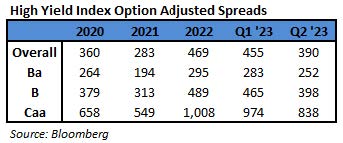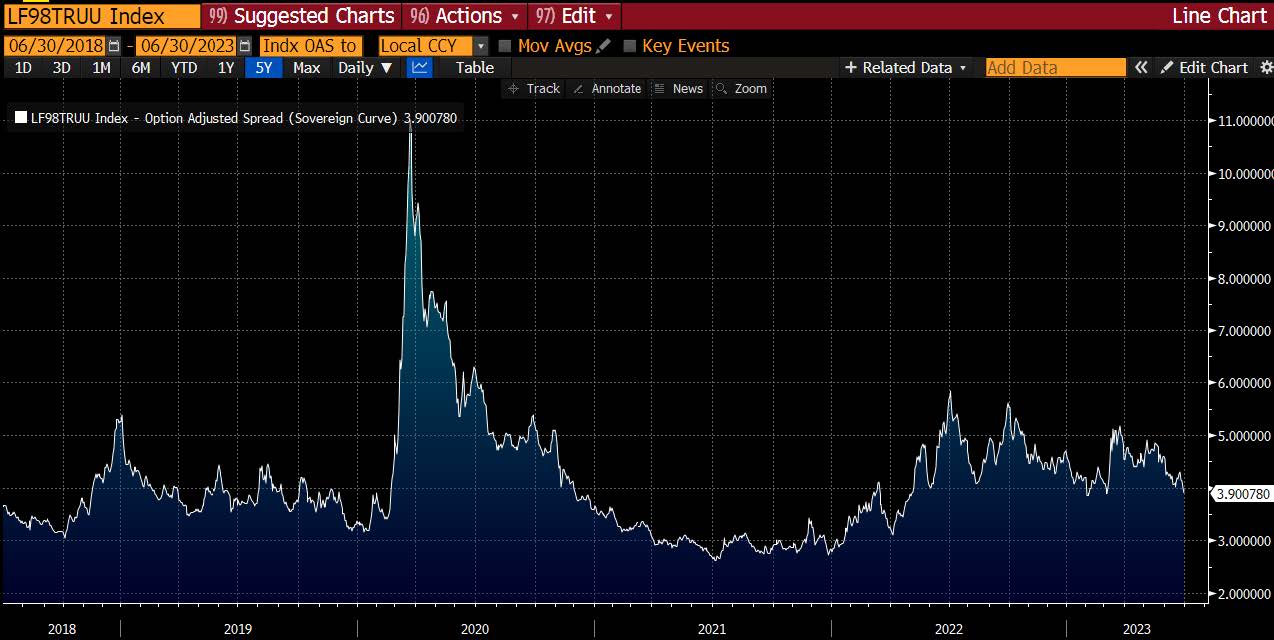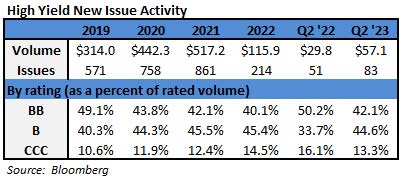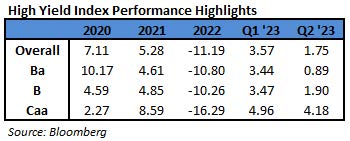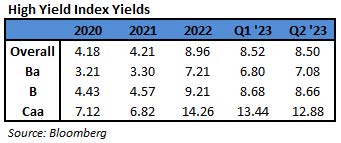2023 Q2 High Yield Quarterly
In the second quarter of 2023, the Bloomberg US Corporate High Yield Index (“Index”) return was 1.75% bringing the year to date (“YTD”) return to 5.38%. The S&P 500 index return was 8.74% (including dividends reinvested) bringing the YTD return to 16.88%. Over the period, while the 10 year Treasury yield increased 37 basis points, the Index option adjusted spread (“OAS”) tightened 65 basis points moving from 455 basis points to 390 basis points.
All ratings segments of the High Yield Market participated in the spread tightening as BB rated securities tightened 31 basis points, B rated securities tightened 67 basis points, and CCC rated securities tightened 136 basis points. The chart below from Bloomberg displays the spread moves in the Index over the past five years. For reference, the average level over the five years is 411 basis points.
The sector and industry returns in this paragraph are all index return numbers. The Other Industrial, Finance Companies, and REITs sectors were the best performers during the quarter, posting returns of 3.90%, 3.66%, and 3.44%, respectively. On the other hand, Banking, Electric Utilities, and Other Financial were the worst performing sectors, posting returns of -1.68%, -0.26%, and -0.09%, respectively. At the industry level, retailers, leisure, and retail REITs all posted the best returns. The retailers industry posted the highest return of 6.39%. The lowest performing industries during the quarter were wireless, life insurance, and paper. The wireless industry posted the lowest return of -2.67%.
While there was a dearth of issuance during 2022 as interest rates rapidly increased and capital structures were previously refinanced, the primary market perked up a bit during the second quarter this year. Of the issuance that did take place, Energy took 23% of the market share followed by Discretionary at an 18% share and Financials at a 15% share.
The Federal Reserve did lift the Target Rate by 0.25% at the May meeting but took a pause at the June meeting. This was the first rate pause during the current 15 month long hiking cycle where the Fed has hiked by 500 basis points. With inflation still too high and the labor market still too tight, Chair Jerome Powell has provided a clear message that additional hikes this year are to be expected. “A strong majority of committee participants expect that it will be appropriate to raise interest rates two or more times by the end of the year,” Powell said, referencing the policy-setting Federal Open Market Committee during a conference at the end of June. “Inflation pressures continue to run high, and the process of getting inflation back down to 2% has a long way to go.”i Powell did acknowledge that the outlook is “particularly uncertain” and noted that the Fed will pay close attention to ongoing economic data releases. With regard to the banking turmoil that started back in March, Powell suggested that more supervision and regulation is likely needed but did note that the US banking system is “strong and resilient.” At this point, treasury rates and high yield spreads are about where they were prior to the banking scare.
Intermediate Treasuries increased 37 basis points over the quarter, as the 10-year Treasury yield was at 3.47% on March 31st, and 3.84% at the end of the second quarter. The 5-year Treasury increased 59 basis points over the quarter, moving from 3.57% on March 31st, to 4.16% at the end of the second quarter. Intermediate term yields more often reflect GDP and expectations for future economic growth and inflation rather than actions taken by the FOMC to adjust the Target Rate. The revised first quarter GDP print was 2.0% (quarter over quarter annualized rate). Looking forward, the current consensus view of economists suggests a GDP for 2023 around 1.3% with inflation expectations around 4.3%.[ii]
Being a more conservative asset manager, Cincinnati Asset Management Inc. does not buy CCC and lower rated securities. Additionally, our interest rate agnostic philosophy keeps us generally positioned in the five to ten year maturity timeframe. During Q2, Index performance was once again tilted toward the lowest rated end of the market as there was a mostly risk-on tone in the quarter. Additionally, given the positive quarterly return of the Index, our natural cash position was a drag on performance for Q1. Our credit selections within communications and energy were also a drag to performance. Benefiting our performance this quarter was our overweight in consumer cyclicals, particularly home construction, and our credit selections in transportation, leisure, and aerospace and defense.
The Bloomberg US Corporate High Yield Index ended the second quarter with a yield of 8.50%. Treasury volatility, as measured by the Merrill Lynch Option Volatility Estimate (“MOVE” Index), has picked up quite a bit the past 18 months. Over that timeframe, the MOVE has averaged 122 relative to a 62 average over 2021. However, the current rate of 110 is well below the spike near 200 back in March during the banking scare. The second quarter had eight bond issuers default on their debt, taking the trailing twelve month default rate to 1.64%.iii The current default rate is relative to the 0.86%, 0.83%, 0.84%, 1.27% default rates from the previous four quarter end data points listed oldest to most recent. The fundamentals of high yield companies still look good considering the uncertain economic backdrop. From a technical view, fund flows were only slightly negative in the quarter at -$0.6 billion after totaling -$24.3 billion during Q1.iv No doubt there are risks, but we are of the belief that for clients that have an investment horizon over a complete market cycle, high yield deserves to be considered as part of the portfolio allocation
The Fed will continue to remain a large part of the story in the second half of this year. While their message to expect more hikes remains clear, market participants have listened as they exited previous positioning for rate cuts later in 2023. As an aggregate of over 50 institutional contributors, the Bloomberg recession probability forecast currently stands at 65%. Naturally, there are plenty of reasons to be cautious as lending standards have tightened and defaults are on the rise. That said, the unemployment rate is sub 4%, demand is resilient, and good fundamentals are still providing cushion. Our exercise of discipline and selectivity in credit selections is important as we continue to evaluate that the given compensation for the perceived level of risk remains appropriate. As always, we will continue our search for value and adjust positions as we uncover compelling situations. Finally, we are very grateful for the trust placed in our team to manage your capital.
This information is intended solely to report on investment strategies identified by Cincinnati Asset Management. Opinions and estimates offered constitute our judgment and are subject to change without notice, as are statements of financial market trends, which are based on current market conditions. This material is not intended as an offer or solicitation to buy, hold or sell any financial instrument. Fixed income securities may be sensitive to prevailing interest rates. When rates rise the value generally declines. Past performance is not a guarantee of future results. Gross of advisory fee performance does not reflect the deduction of investment advisory fees. Our advisory fees are disclosed in Form ADV Part 2A. Accounts managed through brokerage firm programs usually will include additional fees. Returns are calculated monthly in U.S. dollars and include reinvestment of dividends and interest. The index is unmanaged and does not take into account fees, expenses, and transaction costs. It is shown for comparative purposes and is based on information generally available to the public from sources believed to be reliable. No representation is made to its accuracy or completeness. Additional disclosures on the material risks and potential benefits of investing in corporate bonds are available on our website: https://www.cambonds.com/disclosure-statements/.
i Bloomberg June 29, 2023: Powell Says Likely Need Two or More Hikes to Cool Inflation
ii Bloomberg July 3, 2023: Economic Forecasts (ECFC)
iii JP Morgan July 5, 2023: “Default Monitor”
iv CreditSights June 29, 2023: “Credit Flows”

